Search engines are complex systems designed to help users find the information they are looking for quickly and efficiently.
One aspect of search engines that has garnered attention in recent years is the phenomenon of zero-click searches, also known as “no-click” or “one-box” searches.
This article will delve into the mechanics of zero-click searches, how they can impact search engine optimization (SEO), and strategies for optimising for them.
You’ll also find out about the role featured snippets and knowledge panels play in zero-click searches and how businesses and marketers can leverage these features to their advantage.
Overview of the Search Process
When a user searches on a search engine, the search engine algorithm scans through an extensive index of web pages to identify those most relevant to the user’s query.
The algorithms consider various factors, including the query’s wording, the content’s relevance to the question, the authority and credibility of the source, and the user’s location and search history.
Based on these ranking factors, the search engine generates a list of results ranked in order of relevance and displays them on the search results page.
The top-ranked results are typically considered the most relevant and authoritative and are displayed at the top of the page.
What Are Zero-Click Searches?
Zero-click searches, also known as “no-click” or “one-box” searches, refer to instances where a user searches on a search engine and receives the desired information without clicking on any search results.
Zero-click searches rose to 65% in 2020 and are expected to grow further as Google continues to offer direct answers to searches instead of search results.
The answers to these searches are returned as featured snippets or via knowledge panels. These formats of search results are designed to provide users with quick and easy access to information.
Zero-click searches have become increasingly common in recent years as search engines have become more sophisticated at identifying and presenting relevant information to users.
They are a convenient way for users to quickly find the information they are looking for without visiting multiple websites.
Role of Featured Snippets and Knowledge Panels in Zero-Click Searches
Featured snippets are highlighted boxes that appear at the top of the search results page and display a summary of relevant information to the user’s query.
They are typically taken from one of the top-ranked websites in the search results and are intended to give users a quick overview of the main points. Featured snippets can appear for definitions, statistics, lists, and question-based queries.
Knowledge panels are boxes on the right-hand side of the search results page. Searches for particular entities like people, places, or organisations typically trigger knowledge panels.
In addition to traditional search results, search engines may display featured snippets and knowledge panels for specific queries.
Featured snippets and knowledge panels result in zero-click searches because often users do not click on a third-party website after getting the desired information via featured snippets or knowledge panels.
Examples of Zero-Click Searches in Action
Some of the best examples of zero-click searches are:
- Date, time, and age-related searches: Search queries around dates, time, currency conversions, age and names of people, etc.
- Definition-style searches: Search queries around “definition of”, etc.
- Near-me-style searches: Local search queries like “coffee near me”, “best restaurants near me”, etc.
- Question-based searches: Search queries starting from how, what, who, where, when, is, etc.
Here are a few examples of zero-click searches in action:
- If a user searches for the “definition of SEO,” the search engine may display a featured snippet at the top of the page with the definition of SEO. The user can read the meaning without having to click on any of the search results.
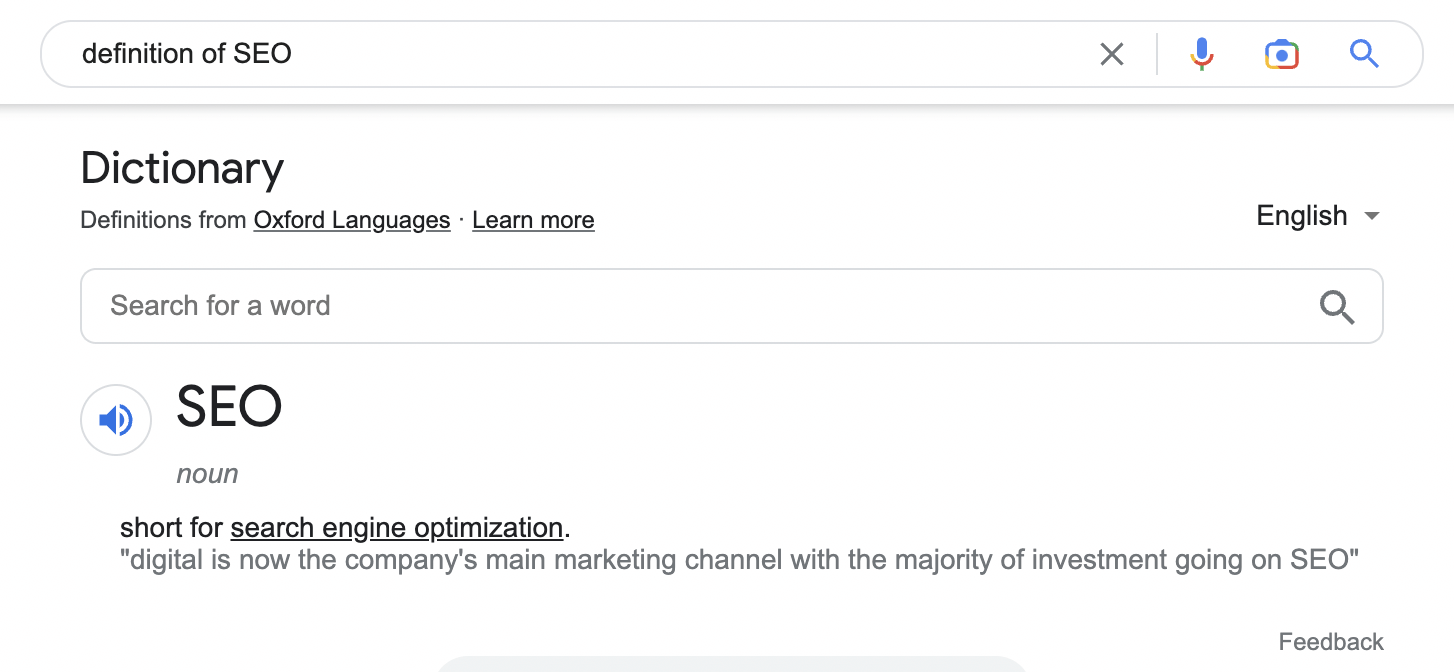
- If a user searches for “Taj Mahal,” the search engine may display a knowledge panel with information about the Taj Mahal, including its location, history, and cultural significance.
- If a user searches for “best Italian restaurants in New York,” the search engine may display a featured snippet with a list of top-rated Italian restaurants in New York, along with ratings and reviews.
- If a user searches for “history of the Holocaust,” the search engine may display a knowledge panel with a brief overview of the history of the Holocaust, along with links to additional resources for further reading.
- If a user searches for “Bob Dylan,” the search engine may display a knowledge panel with information about Bob Dylan, including his biography, career highlights, and notable achievements.
The Impact of Zero-Click Searches on SEO
Zero-click searches can impact search engine optimization (SEO), which is the practice of optimising websites to improve their ranking in search results.
Understanding the impacts of zero-click searches can be helpful for businesses and website owners looking to optimise their websites for search engines and maximise their visibility on the search results page.
Here are the top ways in which zero-click searches impact SEO:
1- Increased Visibility and Traffic
One potential impact of zero-click searches on SEO is the possibility of increased visibility and traffic.
When a website is selected for a featured snippet or knowledge panel, it is given prominent visibility on the search results page, which can help to increase its visibility and traffic.
This can be especially beneficial for websites ranked lower in the search results, as it can help generate more impressions.
2- Increased Competition for Featured Snippets and Knowledge Panels
As zero-click searches have become more prevalent, there has been an increase in competition for featured snippets and knowledge panels. Businesses and website owners constantly strive to optimise their content for these features to increase their visibility and traffic.
This can lead to increased competition for featured snippets and knowledge panels as more businesses and website owners compete for the same space on the search results page.
3- Difficulty in Measuring the Impact of Zero-Click Searches on SEO Metrics
Another challenge businesses and website owners may face regarding zero-click searches and SEO is the difficulty in measuring their impact on SEO metrics.
Traditional SEO metrics, such as traffic, clicks, and conversions, may not fully capture the impact of zero-click searches, as users may not necessarily visit the website to access the desired information. This can make it difficult for businesses and website owners to accurately measure the impact of zero-click searches on their SEO efforts.
4- Potential for Reduced Revenue from Advertising, E-Commerce, or Other Sources
One of the potential impacts of zero-click searches on SEO is the possibility of reduced revenue from advertising, e-commerce, or other sources.
When a user performs a zero-click search and receives the desired information from a featured snippet or knowledge panel, they may not need to visit the website from which the data was taken. This can result in fewer website visitors, impacting its overall traffic and visibility.
This can concern businesses and website owners relying on revenue from advertising, e-commerce, or other sources, as decreased traffic can lead to reduced earnings.
5- The Need to Continually Monitor and Adapt to Changes in Search Engine Algorithms and User Behavior
Finally, it’s essential for businesses and website owners to continually monitor and adapt to changes in search engine algorithms and user behavior when it comes to zero-click searches and SEO.
Search engines are constantly updating their algorithms to provide users with the most relevant and helpful information, which can affect how websites are ranked and displayed in the search results.
In addition, user behavior is constantly evolving, and businesses and website owners must stay updated with the latest trends and preferences to remain competitive in search results.
By monitoring and adapting to changes in search engine algorithms and user behavior, businesses and website owners can ensure that their websites are optimised for search engines and can reach their target audience effectively.
Strategies for Optimising for Zero-Click Searches
Here are the top techniques to optimise your website for zero-click searches:
1- Research Opportunities for Featured Snippets and Knowledge Panels
One key strategy for optimising zero-click searches is researching opportunities for featured snippets and knowledge panels.
This can involve identifying the types of queries most likely to trigger featured snippets and knowledge panels and then creating tailored content for these queries.
To find keywords that trigger featured snippets, you can use tools like Ahrefs.
Enter your competitor’s domain in the Ahrefs keyword research tool and click on SERP features. Now select ‘Featured Snippet’ and remove the other checks.
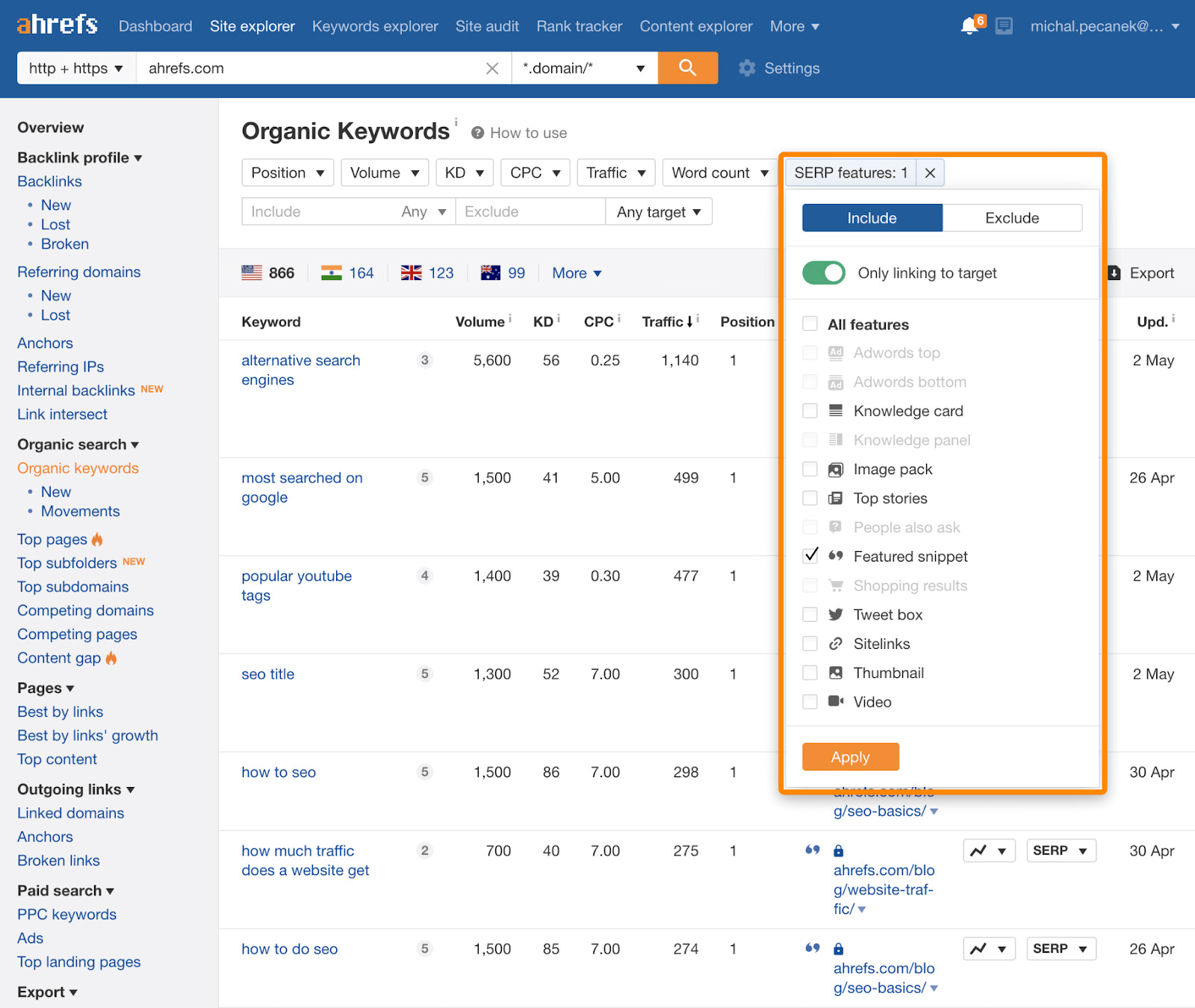
You will be able to see all the keywords where your competitor’s domain ranks as a featured snippet. Similarly, you can repeat the process for other competitor domains to find even more keywords that trigger featured snippet searches.
2- Create High-Quality and Informative Content
Another key strategy for optimising zero-click searches is creating high-quality and informative content.
Search engines are constantly looking for the most relevant and helpful content to display in featured snippets and knowledge panels, and by creating high-quality content, you can increase your chances of being selected for these features.
Here are a few tips for creating high-quality and relevant content:
- Focus on the user: Consider the user’s needs and intent when creating content. What information are they looking for, and how can you provide it clearly and concisely?
- Be comprehensive: Make sure to cover all aspects of the topic in detail. Don’t leave out important details or skip crucial points.
- Use credible sources: Link to authoritative sources to support your claims and add credibility to your content.
- Use clear and concise language: Use clear and concise language that is easy for users to understand. Avoid jargon and technical terms whenever possible, and use headings and subheadings to break up the content and make it easier to read.
- Add FAQs: Frequently asked questions are one of the best ways to enable your site to get ranked for question-based searches. Google looks for web pages that offer the best, most accurate, and original answer to the user query. You can add relevant FAQs in your content to increase your chances of appearing for featured snippet searches.
3- Use Structured Data
Another strategy for optimising for zero-click searches is to use structured data to increase the chances of being selected for a featured snippet or knowledge panel.
Structured data is a standardised format for providing information about a webpage to search engines. It allows search engines to understand the webpage content and display it more effectively in the search results.
By using structured data, you can provide search engines with information about your content in a way that is easy for them to understand and process. This can include information about the page’s content, the type of content it is (e.g., a recipe, an event, a product), and any relevant metadata.
You will need to use structured data in a specific format, such as JSON-LD or Microdata. You can find more information about these formats and how to use them on the www.schema.org website.
Here are the steps to implement structured data on a WordPress website:
- Use a plugin: Several WordPress plugins can help you to add structured data to your website. Some popular options include the WordPress SEO by Yoast plugin and the All-in-One Schema.org Rich Snippets plugin. These plugins allow you to easily add structured data to your website by filling out a form or selecting options from a dropdown menu.
- Use Google’s Structured Data Markup Helper: Another option is to use Google’s Structured Data Markup Helper tool to create the structured data for your website. This tool allows you to highlight the relevant information on your website and add the appropriate structured data. Once you have created the structured data, you can add it to your website by following the below steps.
- Add the structured data manually: Once you have the structured data code, you can add it to the head section of your website using the WordPress Customizer or a plugin such as Insert Headers and Footers.
4- Monitor and Track the Performance of Featured Snippets and Knowledge Panels
To optimise for zero-click searches effectively, monitoring and tracking the performance of your featured snippets and knowledge panels is essential. This can help you to understand how well your content is performing and identify any areas for improvement.
There are several tools and techniques that you can use to monitor and track the performance of your featured snippets and knowledge panels, including:
- Google Search Console: It is a free tool provided by Google that allows you to track the performance of your website in search results. It includes data on the keywords driving traffic to your website and information on any errors or issues with your website.
- Google Analytics: It is a powerful tool that allows you to track your website’s performance in several ways. It provides data on the number of visitors to your website, the pages they visit, and the actions they take. This can help you understand the impact of zero-click searches on your website.
- Custom tracking: You can also create custom tracking solutions to monitor the performance of your featured snippets and knowledge panels. This can involve creating custom tracking codes to track specific events or actions, such as clicks on a featured snippet or knowledge panel.
5. Keep Up to Date with the Latest Trends and Preferences in Search Engine Algorithms and User Behavior
To optimise for zero-click searches effectively, staying up to date with the latest trends and preferences in search engine algorithms and user behavior is essential.
Search engines are constantly updating their algorithms to provide users with the most relevant and helpful information, and understanding these changes can help you to optimise your content accordingly.
Also, being willing to experiment and test different optimization approaches is essential. This can involve testing different types of content, formatting, and metadata to see what works best. By experimenting and testing, you can gain valuable insights into what works and doesn’t and continually adapt and improve your optimization efforts.
6. Optimise Titles, Headings, and Metadata
Optimising your content titles, headings, and metadata can also increase the chances of being selected for a featured snippet or knowledge panel.
These elements play a crucial role in how search engines understand and interpret your content, and by optimising them, you can increase the chances of your content being selected.
Here are a few tips for optimising titles, headings, and metadata:
- Use relevant and descriptive titles: Use tags that accurately describe the content of your page and are relevant to the search query. Avoid using vague or misleading titles, as these can decrease the chances of your content being selected.
- Use clear and concise headings: Relevant subheadings break up your content and make it easier to read. Use clear and concise titles that accurately describe the following content and use formatting (such as bolding or italicising) to highlight key points.
- Use relevant and descriptive metadata: Use metadata, such as the page’s title and description tags, to provide search engines with information about your content. Use appropriate and descriptive metadata that accurately describes the page’s content and is relevant to the search query.
Optimising titles, headings, and metadata make it easier for search engines to understand and interpret your content and increase the chances of your content being selected for a featured snippet or knowledge panel.
7- Use Lists, Tables, and Other Formatting Techniques to Make the Content Easily Digestible and Appealing to Search Engines
Using lists, tables, and other formatting techniques can also be an effective strategy for optimising zero-click searches.
Formatting your content makes it easier for users to digest and understand.
Hence, you can increase the chances of your content being selected for a featured snippet or knowledge panel.
Here are a few tips for using lists, tables, and other formatting techniques:
- Use lists: They break up your content and make it easier to read. Lists can be particularly effective for highlighting key points or steps in a process.
- Use tables: Use tables to present data in a clear and organised manner. Tables can be convenient for comparing different options or presenting data visually.
- Use formatting: Use formattings, such as bolding or italicising, to highlight key points or emphasise important information.
8- Use Clear and Concise Language to Make the Content More Accessible to Users
Using clear and concise language is another critical strategy for optimising zero-click searches.
By using language that is easy for users to understand, you can increase the chances of your content being selected for a featured snippet or knowledge panel.
Here are a few tips for using clear and concise language:
- Avoid jargon and technical terms: Avoid using vocabulary and technical terms that may be unfamiliar to users. Instead, use language that is easy for users to understand and follow.
- Use short sentences and paragraphs: Use short sentences and paragraphs to make your content more easily digestible and accessible. Avoid using long, complex sentences that may be difficult for users to follow.
- Use headings and subheadings: Use headings and subheadings to break up your content and make it easier to read. Use clear and concise titles that accurately describe the content that follows.
9- Monitor the Competition and Learn from Their Strategies
Monitoring the competition and learning from their strategies can also be an effective strategy for optimising for zero-click searches.
By understanding what your competitors are doing, you can learn from their successes and mistakes and adapt your strategies accordingly.
Analyse your competitors’ content to understand what they are doing well and where they may fall short. Look for opportunities to differentiate your content and make it more appealing to users and search engines.
Use tools like SEMrush or Ahrefs to track the performance of your competitors in the search results. This can help you to understand their strengths and weaknesses and identify opportunities for improvement.
10- Use Effective Internal Linking
Internal linking can also be an effective strategy for optimising zero-click searches. Internal linking refers to linking from one page on your website to another.
By using internal linking, you can help search engines better understand your website’s content and structure and increase the chances of your content being selected for a featured snippet or knowledge panel.
Here are a few tips for using internal linking:
- Use relevant and descriptive anchor text: Use appropriate and descriptive anchor text when linking to other pages on your website. This will help search engines understand the content of the linked page and increase the chances of it being selected for a featured snippet or knowledge panel.
- Link to relevant pages: Link to relevant pages on your website whenever possible. This will help search engines understand the content of the linked page and increase the chances of it being selected for a featured snippet or knowledge panel.
- Use a clear and logical structure: Use a clear and logical structure when linking to other pages on your website. This will help search engines understand the content of the linked pages and increase the chances of them being selected for a featured snippet or knowledge panel.
11- Consider the User’s Intent and Tailor the Content Accordingly
Finally, it’s essential to consider the user’s intent when optimising for zero-click searches.
Understanding the user’s purpose will help you create more relevant and helpful content and increase the chances of your content being selected for a featured snippet or knowledge panel.
To consider the user’s intent, you can:
- Research the user’s needs and preferences: Use tools like Keyword Planner and Google Trends to research the needs and preferences of users in your industry or topic. This can help you understand what types of information users seek and tailor your content accordingly.
- Analyse the search results pages: Analyse the search results pages for relevant keywords and phrases to understand the content types displayed in featured snippets and knowledge panels. This can help you to identify opportunities for your content and tailor it accordingly.
- Consider the user’s stage in the purchasing process: Consider the user’s setting in the purchasing process when creating content. For example, if the user is in the research phase, they may be looking for information about the options available, while if they are in the decision-making phase, they may look for reviews or comparisons of different products. Tailoring your content to the user’s stage in the purchasing process can increase the chances of your content being selected for a featured snippet or knowledge panel.
12- Create Content Using the Commonly Used Words in Featured Snippets
Ahrefs did a study and prepared a list of words that trigger featured snippets. Here is the list:
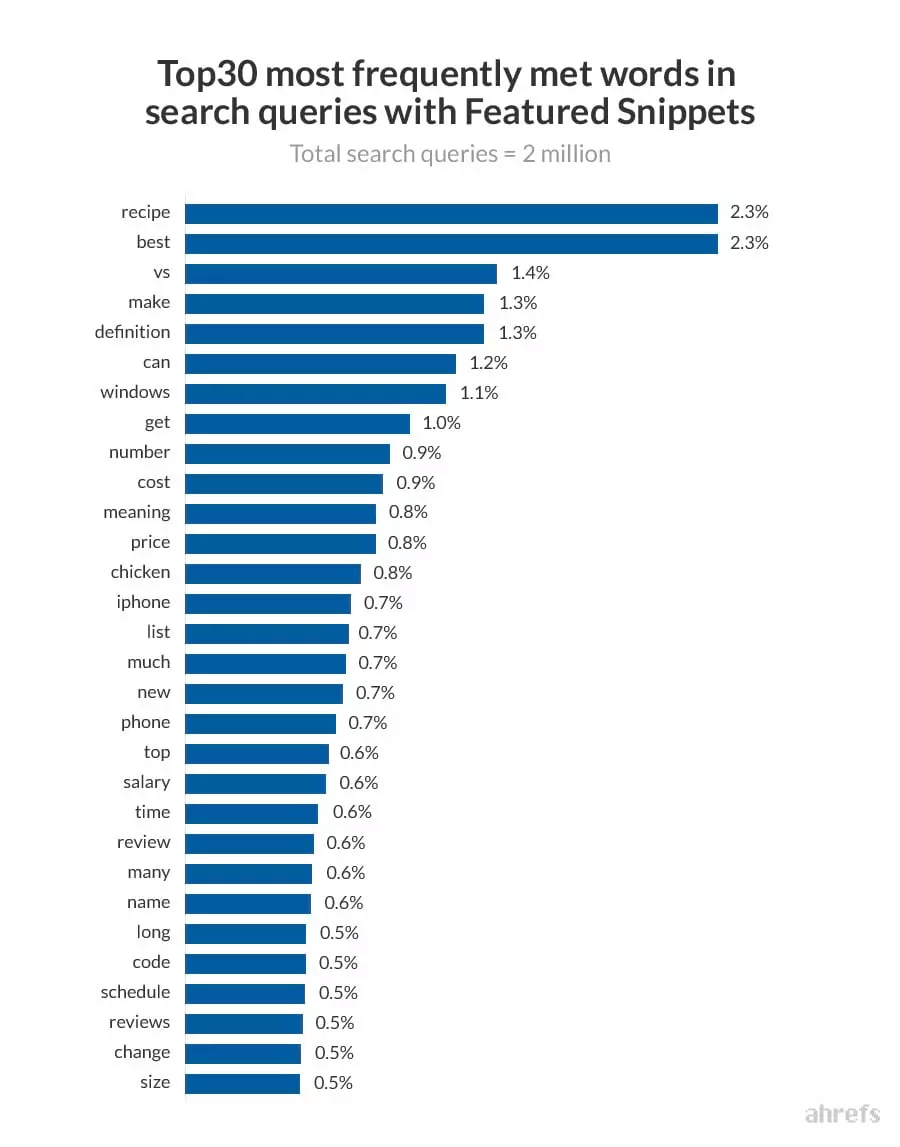
You can pick the above words to focus your content on the exact user intent. For instance, if you are selling SaaS software, you can prepare a list of top software and list your software at the top. Similarly, you can publish a review of your software and provide a detailed overview as to why people should use that software.
Remember, impressions alone can’t bring conversions on your website. Hence, you need to target searches that can acquire more clicks to your site. Clicks lead to action, and action leads to conversion.
Should You Care About Zero-Click Searches?
Zero-click searches are both good and bad. They are good because they improve a business’s branding. If your content ranks as a featured snippet, the number of impressions your site receives increases drastically.
They are bad because a zero-click search takes away the clicks from the website. A site ranking as a featured snippet won’t acquire as many clicks as an organic listing would do.
However, this is not always true. For some queries where the user intent is not fully satisfied after seeing an answer will invite more clicks for zero-click searches.
For example, when I enter a search query like – how old is Elon Musk?, Google returns the below search results:
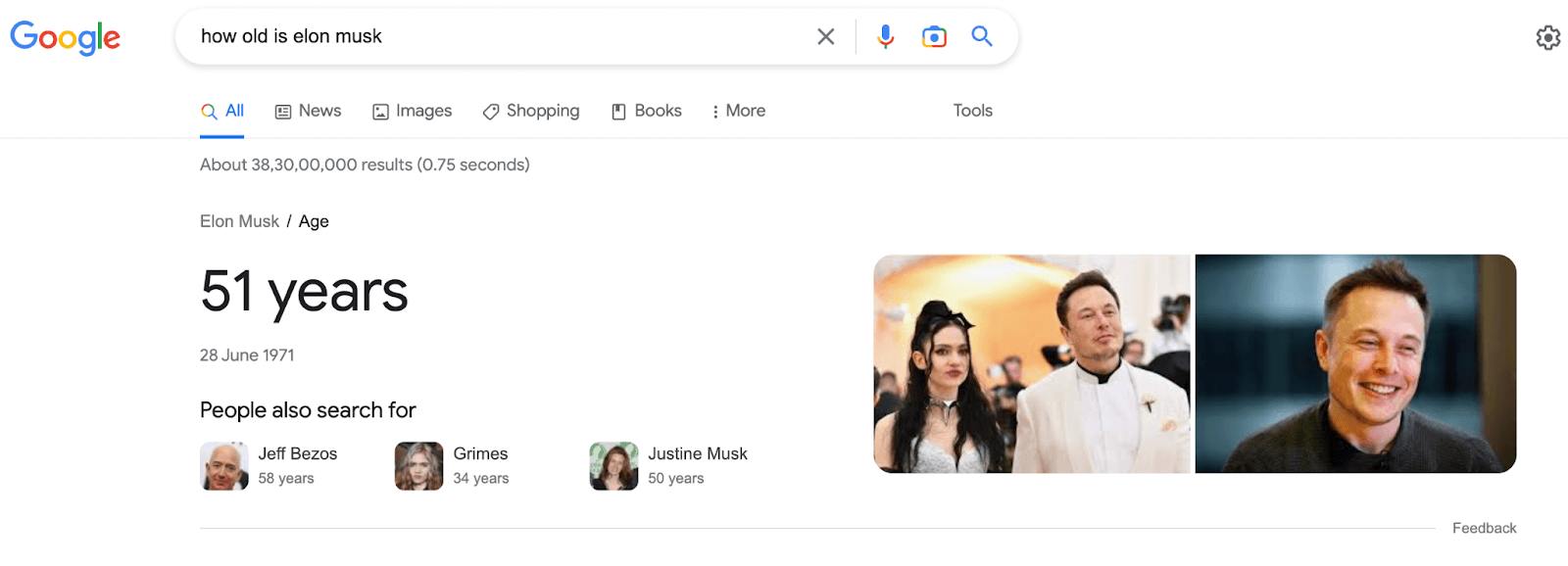
As you can see, Google returns a direct answer to the question, which results in a zero-click search because here, the user intent is satisfied, and searchers might not click on the organic search results.
Now when I enter a key phrase like “how to host a website?”, Google returns the below results:
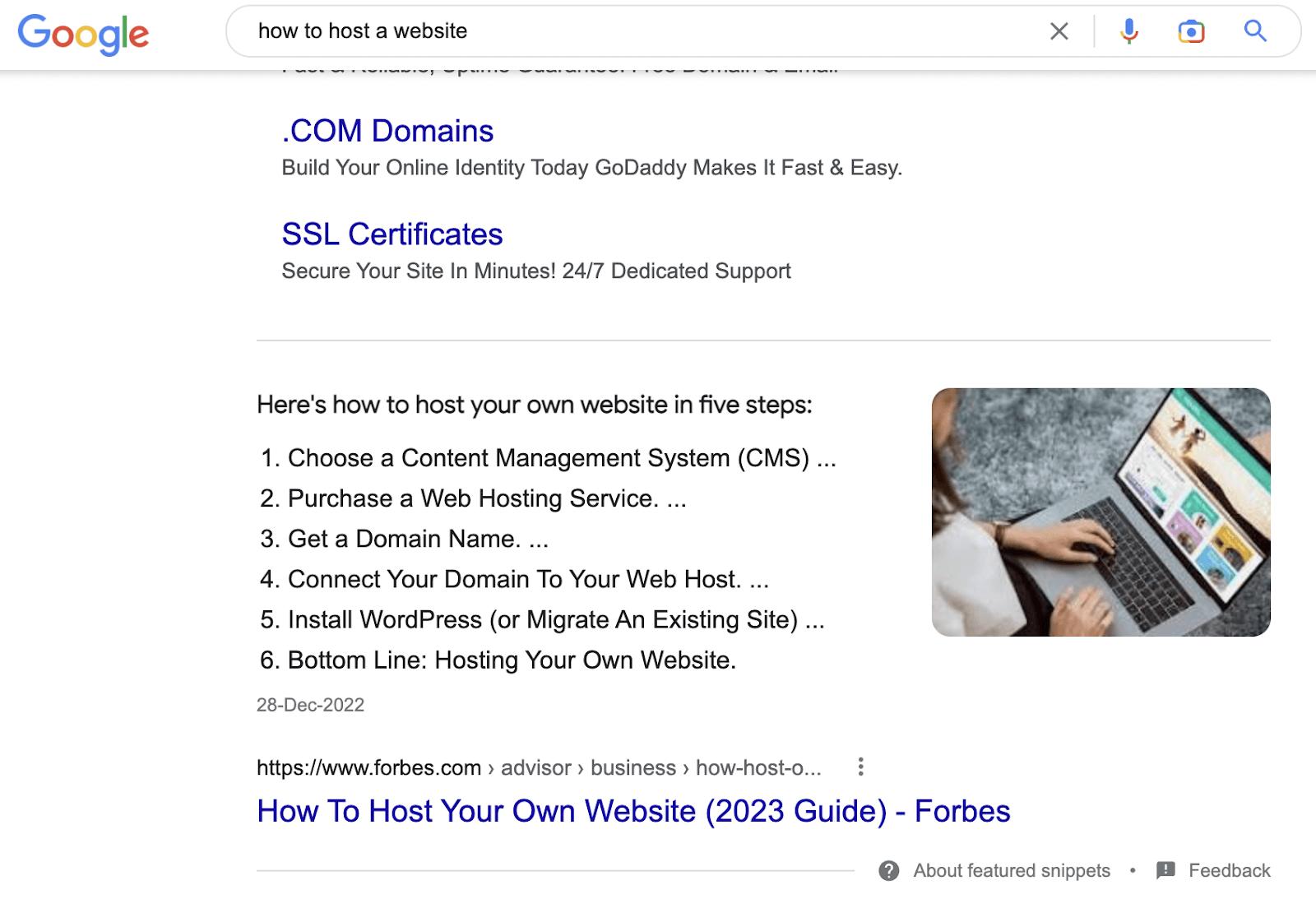
Here, the search intent of the user is somewhat satisfied. Therefore, the users will click on the featured snippet to learn more about the process.
Therefore, you should identify all such search queries where the user intent is not fully satisfied. This will help you to acquire both impressions and clicks.
Which Content Performs Best For Zero-Click Searches?
There are certain types of content that work best for zero-click searches. If you prepare such content for your website, the chances of acquiring the featured snippet search engine real estate will massively increase.
Here are the different content types you should prepare to acquire more traffic from zero-click searches and featured snippets:
- How-To Style Guides: Create content that is comprehensive and explains an entire process to the readers. Step-by-step guides work really well to get your site ranked as a featured snippet. The best part is, how-to guides will pass on clicks to your site as users would be interested in finding the entire process.
- Listicles: List-based articles are another type of content that works great to be listed as a featured snippet. Under this type of content, you can prepare list-based articles such as ‘top 10 lists’, and people will click on them to find the entire list on your site.
- FAQs: As suggested earlier, you can write FAQ-style content to rank your website for question-based searches.
Conclusion
Zero-click searches can significantly impact SEO, and it’s essential to understand how they work and the strategies you can use to optimise for them.
By using the above tips, you can increase the chances of your content being selected for a featured snippet or knowledge panel and improve your SEO efforts.
